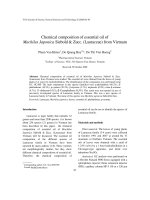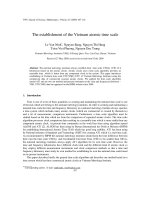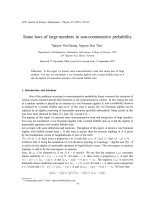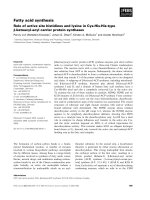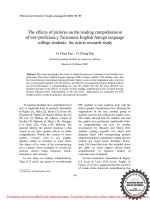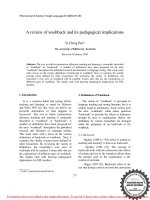Báo cáo "Another method of logic synthesis of digital counting circuits " pptx
Bạn đang xem bản rút gọn của tài liệu. Xem và tải ngay bản đầy đủ của tài liệu tại đây (554.33 KB, 10 trang )
VNU. JOURNAL OF SCIENCE, Mathematics - Physics, T.xXI, n
0
3, 2005
55
Another method of logic synthesis of digital
counting circuits
Nguyen Quy Thuong
Vietnam National University, Hanoi
Abstract. In order to synthesize automat (in this case digital counters), the
minimizing internal states is of particular significance and plays a decisive role
in the results of synthetic circuit. This can be done in many ways, but the use of
Karnaugh map is considered optimal. However, this process has some
disadvantages that it can not be overcome when the number of input variants is
large. In experience, if the number of variants is 7, manual minimization of
circuit functions using Karnaugh map arises many difficulties and even become
impossible if over 10 variants are available.
In order to deal with this weakness, it is both necessary and rational to use
computer in logical synthesis of counting circuit. This is the aim of this article.
1. Synthesizing counting circuits using similar forms
For the method of synthesizing digital counting circuits using computers is
firstly primarily based on the results achieved through the Karnaugh map [1]. By
there results drawning the general laws of circuit functions for each synchronous
and asynchronous counters, for each Flip-Flop (FF) and for each kind of codes.
These general laws help to develop mathematical models as well as computer
programmes which enable the fastest definition of minimized circuit functions of
each desired counters.
Let us investigate, for example, the input states R
2
, S
2
and outputs states Q
2
of RS – FF in synchronous counters, real binary, 4 inputs (k = 4). The input states
R
2
, S
2
as well as outputs states Q
2
are given in table 1.
Table 1. The input states R
2
, S
2
. ε is counting state, ε = 2
k
– 1 = 2
4
- 1 = 15 = m -1,
with m is a cardinal number Q
2
is an output state corresponding inputs states S
2
and R
2
ε
Q
2
R
2
S
2
ε
Q
2
R
2
S
2
ε
Q
2
R
2
S
2
ε
Q
2
R
2
S
2
0
1
2
3
0 d 0
0 0 1
1 0 d
1 1 0
4
5
6
7
0 d 0
0 0 1
1 0 d
1 1 0
8
9
10
11
0 d 0
0 0 1
1 0 d
1 1 0
12
13
14
15
0 d 0
0 0 1
1 0 d
1 1 0
From table 1, we can form impulse diagrams for both Q
2
, R
2
and S
2
(figure 1)
Nguyen Quy Thuong
56
Figure 1: Impulse diagram of Q
2
, R
2
, and S
2
. The dots represent non-defined state
‘don’t care’, which receive either value 1 or 0 when circuit function is reduced and
which can be used or not be depending on certain cases
In this case we particularly study the input state R
2
.
If in minimizing circuit functions using Karnaugh map state ‘don’t care’ is
given value 0, we can have an impulse diagram of R
2
as in figure 2.
Figure 2: Impulse diagram of Q
2
and R
2
to describe forms of circuit functions of R
2
From figure 2 we can see that if Q
2
and R
2
impulses are the same state, the
responding circuit functions have the same form, here called form 1. If Q
2
impulse
flank positive but R
2
impulse flank negative, then circuit functions have the same
form 2. Figure 3 describes the appearance of form 1 and form 2 on ε axis.
Figure 3: Description of form 1 and form 2 on ε axis
Another method of logic synthesis of
57
From figure 3 we can see that if ε = 2, 6, 10, 14…, the corresponding impulse
diagrams have the same for (form 1) and if ε = (3, 4, 5), (7, 8, 9)… the corresponding
impulse diagrams have the same form (form 2). Therefore we say impulse diagrams
corresponding ε in a definite period are similar.
The concept of ‘similar’ is understood in the following way: Two similar circuit
functions are two functions that have the same mathematical structure, such as the
same “sum of products” or “product of sums”, or similar sum, similar product, but
the connotations are different.
This concept of ‘similar’ is the basis on which mathematical models for circuit
functions of counters, in this case synchronous RS-FF counter, real binary code, are
formed.
Also from table 1, using Karnaugh map method, we can define circuit
functions corresponding to inputs R
2
(Table 2).
Table 2: circuit functions corresponding to input R
2
of RS - FF - Counter, k = 4,
ε = 0 to 15
ε
R
2
ε
R
2
ε
R
2
ε
R
2
2
Q
2
6
Q
1
Q
2
+ Q
2
Q
3
10
Q
1
Q
2
+ Q
2
Q
4
14
Q
1
Q
2
+Q
2
Q
3
Q
4
3
4
5
Q
1
Q
2
Q
1
Q
2
Q
1
Q
2
7
8
9
Q
1
Q
2
Q
1
Q
2
Q
1
Q
2
11
12
13
Q
1
Q
2
Q
1
Q
2
Q
1
Q
2
15 Q
1
Q
2
From figure 2, figure 3, table 2 and the concept of “similar” we can see that
circuit functions have two main forms:
Form 1:
ε
=
==Π=
A
(1)
12 l i
l,
i1
R Q .Q Q Q A
{
}
∀ε ∈ 2, 6,10,14
(1)
Form 2:
ε
=
=+ =+
∏
t
(2)
i
l,
i1
RA QAB,
{
}
∀ε ∉ 2, 6,10,14 (2)
with
t
i
i1
BQ
=
=
∏
(3)
If we can prove that the existence of form 1 and 2 follows a certain law, for
example form 1 and 2 exist at the same time in a repetitive period with
denominator ∆ε = 2
ℓ
= 4 (in this case
A
= 2): ε
1
= {(3, 4, 5), (7, 8, 9), (11, 12, 13)…};
ε
2
= {2, 6, 10, 14…} and if we can define the circuit functions of form 1 (as well as
form 2) with
ε
1
= (3, 4, 5) (as well as ε
2
= 2), we can define all circuit functions of
input R
2
(as well as S
2
) with any ε counting state.
Nguyen Quy Thuong
58
1.1 Prove the existence of circuit functions follows a certain law
The problem is we have to prove with any unlimited great k variable input,
that is with any unlimited great ε
counting state, the impulse diagram always
follows a certain law, that is always exist form 1 and 2 corresponding a repetitive
period with ∆ε = 2ℓ (in the case of counter RS=FF).
Assuming that f(ε) = R
(1)
1,
ε
is a function satisfying term Dirichlet of Fourier
theorem on period [3, 4, 5] = [a,b]. In order to develop f(ε) into Fourier series, we
form a periodic function g(ε) having a period either bigger or equal to (b – a) so that
g(ε) = f(ε),
∀ε ∈ [a,b]
Obviously there are many ways to develop g(ε) into Fourier series. For each
g(ε) there is a corresponding Fourier series, therefore there are a number of Fourier
series demonstrating f(ε) = R
1,
ε
(1)
. Similarly, f(ε) = R
1,
ε
(2)
can also be developed into a
Fourier series. To put it simple, the circuit function f(ε) = R
ℓ
,
ε
(1)
+ R
ℓ
,
ε
(2)
with every ε
is periodicall with period ∆ε = 2
ℓ
(in this case ℓ = 2 → ∆ε = 4) (Figure 4).
Figure 4: Circuit function developed into Fourier series with ∆ε = 4
Now that we can assert that with any variable input ℓ, that is the counter can
(theoretically) count to infinite number, then the impulse diagram of circuit
function change periodically in those periods which have similar impulses, that is
circuit functions always have form 1 and 2 according to certain ∆ε.
We particularly study the characters of this law for counters, firstly the
circuit function in form 2.
In order to identify and analyze the forming of form 2 of input state R
ℓ
,
ε
,
we
investigate the circuit function of for example R
3
in RS - FF - Counter with k = 6
(table 3).
Another method of logic synthesis of
59
Table 3. Circuit function with input state R
3,
ε
of RS - FF - Counter with k = 6, ε = 0
to 64, in which: P is the periodical existence of circuit function form 2; F is the
frequency of existence of circuit function in each period P, with corresponding
denominator ∆ε = 2
ℓ
P F
ε
Circuit function in form 2 of R
3
3
ε
0
0
1
2
4
5
6
Q
3
Q
1
Q
3
Q
2
Q
3
2
2
+ 0.2
3
+ 0
2
2
+ 0.2
3
+ 1
2
2
+ 0.2
3
+ 2
1
0
1
2
12
13
14
Q
1
Q
2
Q
3
+
Q
3
Q
4
Q
1
Q
2
Q
3
+
Q
1
Q
3
Q
4
Q
1
Q
2
Q
3
+
Q
2
Q
3
Q
4
2
2
+ 1.2
3
+ 0
2
2
+ 1.2
3
+ 1
2
2
+ 1.2
3
+ 2
2
0
1
2
20
21
22
Q
1
Q
2
Q
3
+
Q
3
Q
5
Q
1
Q
2
Q
3
+
Q
1
Q
3
Q
5
Q
1
Q
2
Q
3
+
Q
2
Q
3
Q
5
2
2
+ 2.2
3
+ 0
2
2
+ 2.2
3
+ 1
2
2
+ 2.2
3
+ 2
3
0
1
2
28
29
30
Q
1
Q
2
Q
3
+
Q
3
Q
4
Q
5
Q
1
Q
2
Q
3
+
Q
1
Q
3
Q
4
Q
5
Q
1
Q
2
Q
3
+
Q
2
Q
3
Q
4
Q
5
2
2
+ 3.2
3
+ 0
2
2
+ 3.2
3
+ 1
2
2
+ 3.2
3
+ 2
4
0
1
2
36
37
38
Q
1
Q
2
Q
3
+
Q
3
Q
6
Q
1
Q
2
Q
3
+
Q
1
Q
3
Q
6
Q
1
Q
2
Q
3
+
Q
2
Q
3
Q
6
2
2
+ 4.2
3
+ 0
2
2
+ 4.2
3
+ 1
2
2
+ 4.2
3
+ 2
5
0
1
2
44
45
46
Q
1
Q
2
Q
3
+
Q
3
Q
4
Q
6
Q
1
Q
2
Q
3
+
Q
1
Q
3
Q
4
Q
6
Q
1
Q
2
Q
3
+
Q
2
Q
3
Q
4
Q
6
2
2
+ 5.2
3
+ 0
2
2
+ 5.2
3
+ 1
2
2
+ 5.2
3
+ 2
.
.
.
.
.
.
From table 3 we can form the relation between P, F and ε for two forms of
circuit functions. (Figure 5)
with ∆ε = 2
ℓ
= 2
3
= 8
Nguyen Quy Thuong
60
Similarly, with R
4:
with ∆ε = 2
ℓ
= 2
4
= 16
Figure 5: Description of the relation between P, F of circuit function R
3
and R
4
on ε axis
Circuit functions of form 1 and 2 depend on ε, ℓ (ℓ
∈ k). This dependence is
demonstrated by the periodical existence of P and frequency of existence in each
period F (See table 3 and Figure 4)
From table 3 and figure 5 we can identify the relation between ℓ, ε, P and F,
that is the relation as well as the mathematical models showing the existence law of
circuit functions:
ε
ℓ
= 2
ℓ
-1
+ P.2
ℓ
+ F (4)
From (4) we have:
l-1
l
ll
ε
2+F
=P+
22
(5)
Put
I =
l-1
I=2 +F (6)
Apply to (6) we have
l
ε-I
P=
2
(7)
From (5), (6), and (7) we see that parameter I can show the complete
frequency and periodical existence of circuit function.
Call E set of I from I
0
to I
max
, we have:
E = {I
0
, I
1
, I
2
, …, I
max
} (8)
E = {F
0
+ 2
ℓ
-1
, F
1
+ 2
ℓ
-1
, …, F
max
+ 2
ℓ
-1
} (9)
or E = { 2ℓ-1, 1 + 2ℓ-1, 2 + 2ℓ-1 …, 2ℓ - 2} (10)
with F
max
= 2
ℓ
- 2
Another method of logic synthesis of
61
Obviously now the value of set E shows the complete parameters of periodical
as well as frequency existence of forms of circuit functions (from F
0
to F
max
), in other
words, in order to identify P and F we only have to identify the value of set E.
Figure 6 shows the existence of circuit function with E corresponding R
3
(ℓ = 3).
Figure 6: Describes the existence of period P and frequency F through set E
If we look into figure 6, we can see that for each R
3
, if E ∈ {4,5,6} the circuit
function will have form 2 and E
∉ {4,5,6} form 1.
1.2 Identifying circuit function
Another problem is that we have to identify the circuit functions of input ℓ for
any counting state ε, in other words, we have to identify to relation between input
state R
ℓ
and output state Q
ℓ
through counting state ε.
Identify circuit function form 1:
With
=
=Π
A
i
i1
AQ
, we can obviously identify circuit function for any ℓ ∈ k. for
example the third input of RS-FF - counter, that is ℓ = 3, has circuit equation as
following:
R
3,
ε
=
3
i
i=1
Q
∏
= Q
1
. Q
2
. Q
3
ε satisfies E ∉{4,5,6}
with any ℓ we have:
l
l,ε i12 l
i=1
R = Q =Q .Q Q
∏
ε satisfies E ∉{2
ℓ
-1
, 1 + 2
ℓ
-1
, 2 + 2
ℓ
-1
…, 2
ℓ
- 2}
* Identifying circuit function form 2:
The problem is to identify circuit functions
k
i
i=1
B= Q
∏
Nguyen Quy Thuong
62
Through investigating circuit functions forms B for input R (as well as S) of
counter RS – FF we have an interesting remark: for each different ε counting state
there is very different circuit function, apparently not following any law (see table
3) but if we look at the relation between binary number and decimal number we will
see that the binary number showing the total weight
η
B
of Q
ℓ
equals to the decimal
number showing counting state ε, that is,
η
B
= ε.
Assuming that the counter has k inputs, then the corresponding weight to
each input will be:
Q
k
Q
A
Q
5
Q
4
Q
3
Q
2
Q
1
η
k
A
η
η
5
η
4
η
3
η
2
η
1
2
k-1
1
2
−A
2
4
2
3
2
2
2
1
2
0
Now the total weight of Q
1
to Q
k
is
η
B
= b
k+1
. 2
k
+ b
k
. 2
k-1
+ … + b2
2
+ b
0
1
=
k
i-1
i
i=1
b.2
∑
(11)
And from the conclusion
ε = 19, k = 5 we have
η
B
= 19 = b
6
. 2
5
+ b
5
. 2
4
+ b
4
. 2
3
+ b
3
. 2
2
+ b
2
. 2
1
+ b
1
. 2
0
= b
6
. 32
+ b
5
. 16 + b
4
. 8 + b
3
. 4 + b
2
. 2 + b
1
. 1
= 0.32 + 1.16 + 0.8 + 0.4 + 1.2 + 1.1
That factors b
6
, b
4
, b
3
must equal to 0 and b
5
= b
2
= b
1
= 1 when
η
B
= 19
In other words, when k = 5 with
ε = 19 the circuit function B will have Q
ℓ
=
(Q
4
, Q
1
. Q
0
), that is,
5
19,5 i 0 1 4
i=1
B= Q=Q.Q.Q
∏
Now we can form a formula to find B:
()
=Π +
=
k
BQb
ii
i1
, with
=
=
=
1b0
i
b
i
0b1
i
(12)
From this we can form the formula to identify the circuit function for each
corresponding
R
l,
ε
of RS - FF - Counter
t
R.Q.Q(Qb).
iii
B
,A
i1 i1
=∆ +∆ + ∆
∏∏
==
A
A
AA
ε
(13)
In which:
ε≥ −
∆=
A
121
A
0othercases
∆
A
shows the condition for the existence of form A
Another method of logic synthesis of
63
{
}
−−−
=+ ∈= + −
−−
∆= η=ε− = = η+
∑
=
A
l1 l1 l1 l
1 I F 2 E 2 , 1 2 , , 2 2
t
1i1
2b.2tld1
BB B
i
i1
0othercases
∆
B
shows the condition for the existence of form B
=
∆=
A
A
11
0 other cases
∆
A
shows the condition for the existence of input 1=A
The identification of
S
l,
ε
is done similarly.
2. Conclusion
From the above results we can form a mathematical model for RS - FF -
Counter and through their relation [1] (figure 7) we can identify the circuit fuction,
that is the mathematical model for all counters namely JK-FF, T-FF, D-FF
…
&
&
S
C
R
T
Q
&
&
S
C
R
Q
J
K
S
C
R
Q
T - FF JK - FF D - FF
D
S = TQ
R = T
Q
S = JQ
R = KQ
S = D
R = D
Figure 7: The relation between RS-FF with T-, JK-, D-FF
For example define the circuit function of D – FF. From figure 7 we can see
that circuit function of D – FF is:
D = S
or D =
R
That is:
Nguyen Quy Thuong
64
t
,
i
,AiBi
i1 i1
DR .Q .Q(Qb).
==
== + +
A
A
A
A=
(14)
With these mathematical models and with software such as Pascal, C
++
, and
especially Mathlab we can easily designsynchronous or asynchronous counters, for
all codes, with any cardinal numbers using computers.
References
1. G. Scarbata, Synthese und Analyse Digitaler Schaltungen, Oldenbourg
Verlag M
ỹnchen Wien, 1996.
2. Nguy
n Đình Trí, Tạ Văn Đĩnh, Nguyễn Hồ Quỳnh, Toán học cao cấp -
Phép tính giải tích một biến số,
NXB Giáo Dục, Hà nội, 2004, 415 trang.
